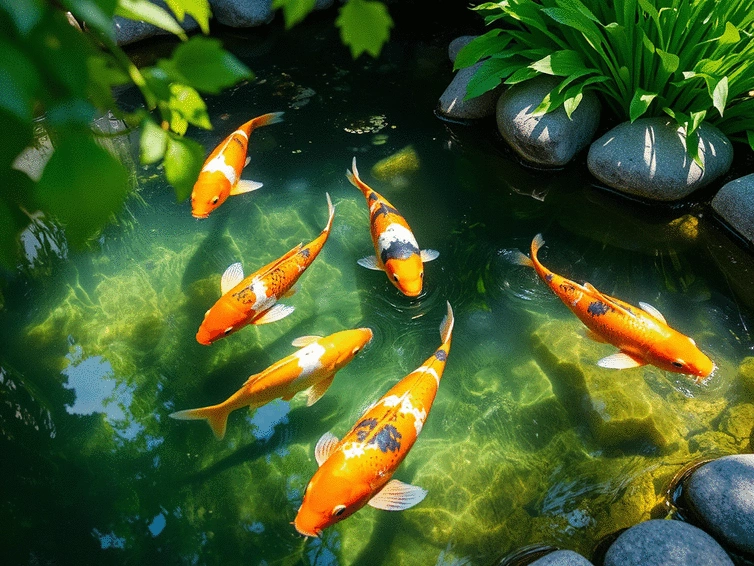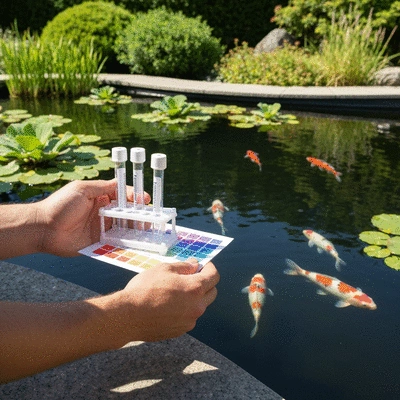Ammonia Levels
Ammonia is highly toxic. Sources include fish waste, uneaten food, and decaying plants.
Symptoms: Gasping, red gills, unusual swimming.

Did you know that maintaining optimal water quality can significantly extend the lifespan of your koi? Understanding the key elements that contribute to a healthy pond is essential for any koi enthusiast. Dive into the world of koi care and learn how to create a thriving aquatic environment for your beloved fish.
Maintaining optimal water quality is paramount for the health and vitality of your koi. The following visual highlights the critical parameters that require regular monitoring and management to ensure a thriving pond ecosystem.
Ammonia is highly toxic. Sources include fish waste, uneaten food, and decaying plants.
Symptoms: Gasping, red gills, unusual swimming.
Byproducts of the nitrogen cycle. High levels cause stress and are toxic.
Solution: Biological filtration, regular water changes.
Koi prefer stable pH (7.0-8.0). Fluctuations cause stress.
Solution: Use test kits, add natural buffers (oyster shells).
Essential for koi health and metabolism. Low levels impact activity.
Solution: Aeration (pumps, fountains), aquatic plants.
As a koi pond enthusiast, I can’t stress enough how water quality plays a pivotal role in the health, growth, and longevity of your koi. Your fish thrive in a balanced environment, where parameters like temperature, pH, and nutrient levels are just right. When these elements are off, you might notice behavioral changes in your koi, which can lead to serious health issues if not addressed promptly.

To ensure your koi remain vibrant and healthy, it’s essential to regularly monitor water quality. This not only keeps your fish happy but also enhances the beauty of your pond. Remember, a thriving koi pond is a reflection of the care you put into maintaining its water quality!
Water quality significantly impacts koi health. Poor water conditions can lead to stress, disease, and even fatalities. To maintain a thriving pond ecosystem, focus on these key areas:
By ensuring these factors are within optimal ranges, you promote a healthy, vibrant habitat for your koi to flourish. Regular testing is your best friend in maintaining these conditions!
Understanding the common water quality issues can help you take early action to protect your koi. Let’s delve into some of the most frequent problems faced by koi pond owners:
Ammonia spikes are one of the most critical issues for koi ponds. Sources of ammonia can include fish waste, uneaten food, and decaying plant matter. Symptoms of ammonia poisoning in koi include:
Monitoring ammonia levels regularly is crucial because even small spikes can be harmful. Utilizing an ammonia test kit can help you stay proactive in managing this vital aspect of your pond’s environment!
Nitrites and nitrates are byproducts of the nitrogen cycle in your pond. High levels can be toxic to koi and lead to stress. To mitigate these issues, consider:
By keeping these levels in check, you create a healthier environment for your koi, ensuring they have the best chance to thrive!
The pH level is another crucial factor to monitor. Koi thrive in a neutral to slightly alkaline environment. You can measure pH using test kits available online or at your local pet store. To stabilize pH levels, consider adding natural buffers like oyster shells to your pond. This not only helps maintain balance but also provides essential calcium for your koi.
Dissolved oxygen is essential for koi health, influencing their metabolism and overall well-being. To check oxygen levels, use a dissolved oxygen test kit. If levels are low, here are some effective strategies:
Maintaining adequate oxygen levels ensures that your koi remain active and healthy. Remember, a lively koi pond is a happy pond!
As you embark on your koi pond maintenance journey, we'd love to hear your strategies! What is the most effective method you've found for managing water quality in your koi pond?
As we've journeyed through the intricacies of koi pond water quality, it's clear that managing these factors is crucial for the health and vitality of your beloved koi. We've discussed several common water quality problems, such as ammonia spikes, nitrite and nitrate levels, and the importance of maintaining stable pH levels. Additionally, we've explored practical solutions like enhancing aeration and utilizing aquatic plants to create a thriving ecosystem. Remember, healthy water means happy koi!
These strategies not only help maintain clear and balanced water but also promote a healthier environment for your koi. At Best Koi Ponds, I encourage you to be proactive in your pond maintenance to ensure your koi live long, vibrant lives.
Now that you're equipped with knowledge about managing water quality, it’s time to put these practices into action! Begin by establishing a consistent testing routine—this will help you catch any potential issues before they become serious. Don’t hesitate to upgrade your filtration system if you notice signs of distress in your koi, as an effective filtration system is the heart of your pond. Additionally, consider incorporating aquatic plants, which not only beautify your pond but also serve as natural filters!
These steps can significantly enhance the overall health of your koi pond. Remember, every little effort adds up to create a stunning aquatic habitat!
Your journey as a koi keeper doesn’t end here! I invite you to subscribe to our newsletter for the latest updates, tips, and insights into maintaining your koi pond. Share your experiences with our community—your stories might inspire others in their pond adventures. Plus, keep an eye out for our product recommendations that can help you maintain optimal water quality.
Let's continue growing this wonderful community of koi enthusiasts together. Your koi's health is worth every effort!

Here is a quick recap of the important points discussed in the article:
Koi Pond Water Quality Solutions

Did you know that maintaining optimal water quality can significantly extend the lifespan of your ko
Naturalizing Your Koi Pond Plants

Did you know that aquatic plants can significantly enhance the health and beauty of your koi pond? T
Koi Pond Shape and Size Guide
Koi Pond Water Quality Solutions
Naturalizing Your Koi Pond Plants
Koi Pond Equipment: Pumps, Filters, Liners
Koi Pond Water Test Kit Guide